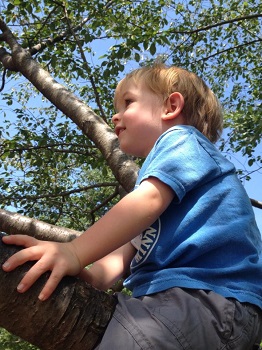In a recent NPR story on play, correspondent Jon Hamilton made the case that play is good for the developing brain. As a parent and former educator, I couldn’t agree more. I am often struck by the determent of unstructured play by parents, teachers, and caregivers, even in the toddler years.
 I remember a particular instance when my son was playing with another young child who had a toy. The boy’s two parents verbally navigated his play for him – giving one command after another as to what to do with the toy – for about five minutes. It seemed they really wanted to be sure he played with it the “right” way, rather than allowing him to discover for himself the most effective or (gasp!) fun way to play with the toy.
I remember a particular instance when my son was playing with another young child who had a toy. The boy’s two parents verbally navigated his play for him – giving one command after another as to what to do with the toy – for about five minutes. It seemed they really wanted to be sure he played with it the “right” way, rather than allowing him to discover for himself the most effective or (gasp!) fun way to play with the toy.
As I listened to Hamilton’s story, I couldn’t help but think of the many ways the local parks in our own backyards offer the ideal setting for valuable, brain-altering play. Parks are places where children gather and connect, where they can learn and explore. Here are just a few reasons to why playing in the park is good for kids’ brains.
Unplugged play
We have all heard the alarming statistics on the amount of screen time our kids are consuming – up to 7 hours per day, on average – and the damaging effects on the developing brain. Kids who spend their free time playing video games or using other electronic media naturally have less time for healthier forms of play. Play time in the park is, for the most part, unplugged. Whether a pickup basketball game or a trip down the slide, at the park, kids can take a break from their devices.
Active play
Not only are kids getting more and more screen time, but they are less active, as well. This combination is dangerous for children’s health, and it can affect their ability to do well in school. From ball fields to disc golf courses to swimming pools, our local parks offer kids many opportunities to have fun and get active.
Outdoor play
A growing body of research shows that it is important for our brains and bodies to spend time outdoors. When kids play outside, they are healthier, happier, and better able to concentrate. For many kids living in urban and suburban areas, playing outside means playing in the park. Local parks offer safe places for kids to spend time outdoors.
Nature play
Of course, nature play takes place outdoors, but playing in and with nature is quite different from playing in an outdoor swimming pool or playground structure. Giving kids the chance to explore, take risks, build a fort, and get dirty is an invaluable role of local parks. When kids are given opportunities for free play in nature, they are healthier and smarter, and they care more for the environment.
NRPA is proud to join a number of other national partners to support the efforts of the National Wildlife Federation and the Natural Learning Initiative at North Carolina State University to develop Nature Play and Learning Areas Design Guidelines, due out next month. The Guidelines will offer tested, research-based strategies for engaging kids and families in outdoor play – supporting healthy brains and bodies. Be sure to check out the September issue of Parks & Recreation Magazine to learn more.
How does your park and recreation agency foster children’s development through play? We’d love to hear from you. Share your thoughts in the comments or on twitter @NRPA_News.
Jessica Culverhouse is NRPA's Senior Manager of Fundraising. She is a former teacher and environmental educator, mom and volunteer Master Naturalist.

